Eugenius Birch opens his new 910ft pier
This article contains affiliate links. We may earn a small commission on items purchased through this article, but that does not affect our editorial judgement.
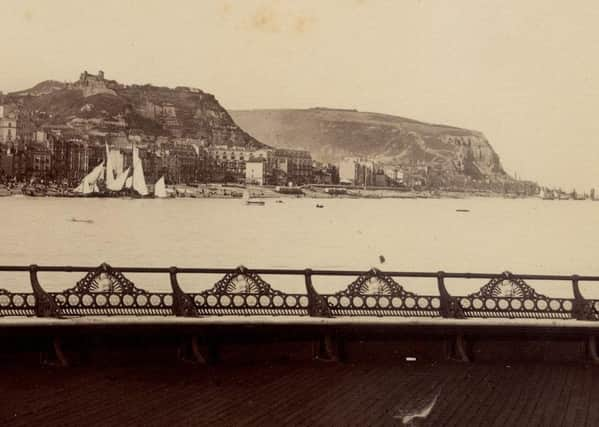

He writes. It incorporated an ornate 2000-seat pavilion at the seaward end with a long promenade deck leading up to it.
A £2,000 landing stage was added in 1885 but encroachment onto the deck only began in 1910/11 when a small building housing a shooting gallery, ‘animated pictures’ and slot machines was added, followed in 1912, by a rifle range/bowling alley.
Advertisement
Hide AdAdvertisement
Hide AdThis shoreward end of the pier, known as the ‘parade extension’, was sold to the council in 1913 to finance a new arcade, shops and a tea-room. The pavilion was destroyed by fire on July 15 1917 and the 1922 replacement was less elaborate.
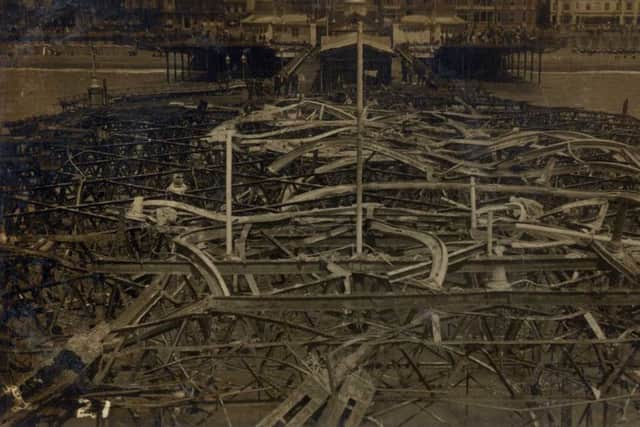

A new pavilion was built in 1926 at the shoreward end and an Art Deco facade was added in the 1930s. The openness of the original pier was not to return until it reopened in 2016 and with it the opportunity of capturing images and panoramas of the full length of Hastings and St.Leonards’ seafront.
As can be seen in many of the illustrations, the whole of the promenade area was bounded by ornate seating, the cast iron backs of the seats forming the pier’s protective perimeter boundary and probably contributing to its structural integrity, this seating was removed and not replaced when the pier was widened. There would be serious health and safety implications if this style of pier furniture were used today.
Some of the views afford rare glimpses of Viscountess Jocelyn’s House, White Rock Villa between the Grand Hotel on the left and the Hospital on the right where “Fanny” as Lady Jocelyn was known, moved in 1858 at the same time as becoming a member of the Photographic Society of London.
Advertisement
Hide AdAdvertisement
Hide AdAt the age of 17 she had been chosen by Queen Victoria to be one of the train-bearers at her Coronation in June 1838 and later she was one of the twelve bridesmaids at Queen Victoria’s marriage to Prince Albert in 1840. After a spell as an orphanage the a store the Villa was demolished by the corporation as part of the White Rock Improvements of the 1920’s
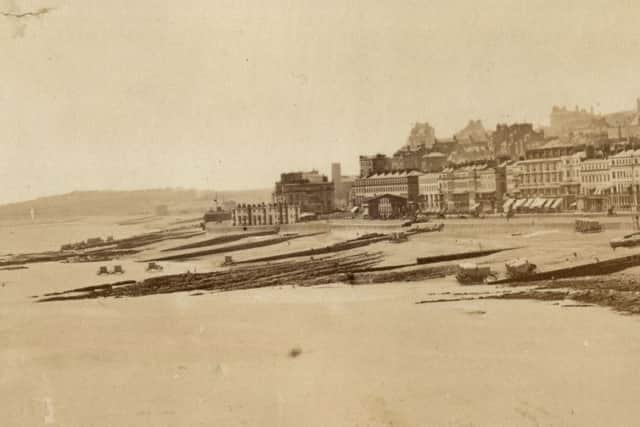

All illustrations throughout this series are from Ion Castro’s own collection and he can make available copies of many of the historic images used in this series. There’s more local history on Ion’s website, www.historichastings.co.uk.
Captions:
Hastings East Sussex Hospital from Pier.
The hospital with its circular wards at each end was to survive until 1923 when it was replaced with the Royal East Sussex nearby in Cambridge Road and the site occupied by the White Rock Pavilion. The east toll-booths are in the foreground.
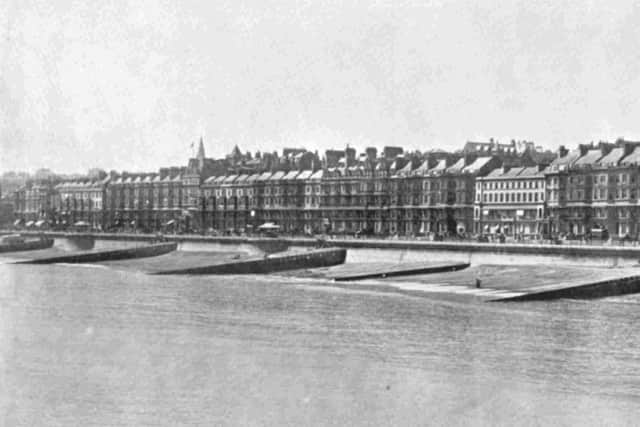

Hastings from Pier – LL.
LL postcards was a French company that produced postcards etc. for a wide variety of locations including USA and England and are often wrongly assumed to be the work of Louis Levy, but research has shown that nobody of that name was ever associated with the company. This error seems to have arisen through confusion with an American called Louis Levy, who was involved in early photography and, with his brother Max, developed various important photographic processes. The research has revealed that Levy Fils et Cie who used the initials LL that appear on the front of these postcards in fact stood for (Moyse) Leon and his son-in-law (Isaac) Levy. The image can be accurately dated to 1905 when the ‘Halcyon’, built in 1887 by J Scott at Kinghorn, Fife, was acquired by the South of England Steamboat Co, but returned to the General Steam Navigation Company (GSN) later that year as her new owners went into liquidation. Note White Rock Villa.
Panorama East.
Advertisement
Hide AdAdvertisement
Hide Ad“Panoramic View of Front, East of Pier” – Local Photographer Bradshaw took advantage of the pier as a vantage point to capture the East and the Western Panoramic views in 1900.
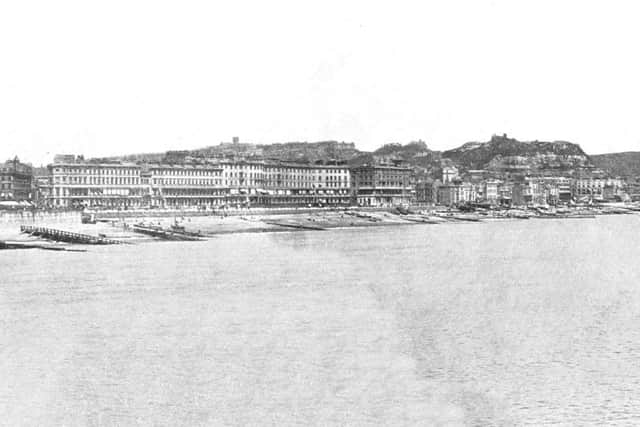

Panorama West.
“Panoramic View of Front, West of Pier” - Bradshaw.
Pier after Fire
1917 July 15 – A major fire destroyed the ornate pavilion at the seaward end of Hastings Pier. It was thought to have been caused by one of the Canadian soldiers stationed in the town discarding a cigarette. Considerable damage was caused and a replacement pavilion wasn’t built until 1922.
St Leonards from the Pier.
Dating from the 1870’s this uncredited albumen print shows in the distance Martello Tower 43 at Bulverhythe and 39 at Grosvenor Gardens. South Colonnade, opposite where Marine Court would be built and cleared in the late 1940’s can be seen as can St.Leonards Arch, removed in 1895 and notice the bathing machines in the right foreground.
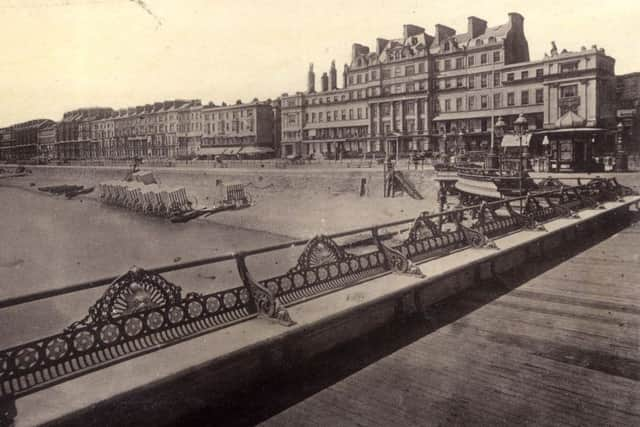

Hastings: the Parade from the Pier.
Dating from the end of the 19th Century and No 3210 in a series of uncredited photographs, the buildings west of the Grand Hotel appear little changed. Sidney Little’s Bottle Alley would appear some thirty years later and notice the bathing machines.
From the end of the Pier.
Advertisement
Hide AdAdvertisement
Hide AdAn uncredited photogravure from 1905 advertising the steamer ‘Halcyon’ and showing how much narrower the pier was then. White Rock Villa can be seen between the hospital and the Grand Hotel. A large chunk of the western end of the hospital was removed when the whole area was remodelled in the 1920’s.
Looking East.
An unknown photographer took this photograph in the 1870’s, it shows the tower of Emmanuel church, consecrated in 1874 on the skyline, no East Hill Lift – that would have to wait until 1902 and no harbour of course, that would have to wait until 1896. Note the blocks of bathing machines, Ladies separated from Gentlemen and the pleasure yachts drawn up by the Queens Hotel (opened in 1862) and the fishing boats below the East Cliff. The enigmatic ‘St George’s Churchyard’ can be seen on top of the East Hill. Sidney Little would remove the buildings in front of Pelham Crescent as part of the seafront improvements in the 1930’s and Robertson Terrace with the Albany Hotel in its centre was to retain its classical splendour until modified by the Luftwaffe in the last war.
Don’t miss out on all the latest breaking news where you live.
Here are four ways you can be sure you’ll be amongst the first to know what’s going on.
Advertisement
Hide AdAdvertisement
Hide Ad1 Make our website your homepage at www.hastingsobserver.co.uk
2 Like our Facebook page at www.facebook.com/hastingsobserver
3 Follow us on Twitter @HastingsObs
4 Register with us by clicking on ‘sign in’ (top right corner). You can then receive our daily newsletter AND add your point of view to stories that you read here.
And do share with your family and friends - so they don’t miss out!
The Hastings Observer - always the first with your local news.
Be part of it.